Discover Moshi City: Your Guide to Adventures and Culture in Tanzania

Nestled in northern Tanzania, Moshi serves as the capital of Kilimanjaro region and gateway to Mount Kilimanjaro.
With a population of 221,733 residents within its compact 59 square kilometers, this urban hub blends modern amenities with breathtaking natural surroundings.
The town provides essential services for those preparing to climb Kilimanjaro while maintaining its authentic local character.
Coffee plantations dot the surrounding countryside, evidence of the region's agricultural heritage.
| Statistic | Value |
|---|---|
| Population (2022 census | 221,733 residents |
| Area | 59 km² |
| Elevation (town center) | ~700 meters above sea level |
| Town status | 1956 (municipality, 1988) |
| Regional capital of | Kilimanjaro Region |
Moshi offers visitors a unique Tanzanian experience, from its bustling markets to the nearby mountain slopes.
As the primary access point for Kilimanjaro National Park, Moshi welcomes adventurers from around the world while preserving its Swahili culture and Chagga traditions.
The town’s elevation of 700 meters above sea level ensures comfortable temperatures year-round, making it an ideal base for exploring northern Tanzania’s attractions.
The administrative importance of Moshi extends beyond tourism, with the city serving as the governmental and commercial heart of Kilimanjaro region.
Moshi City: Capital of Kilimanjaro Region
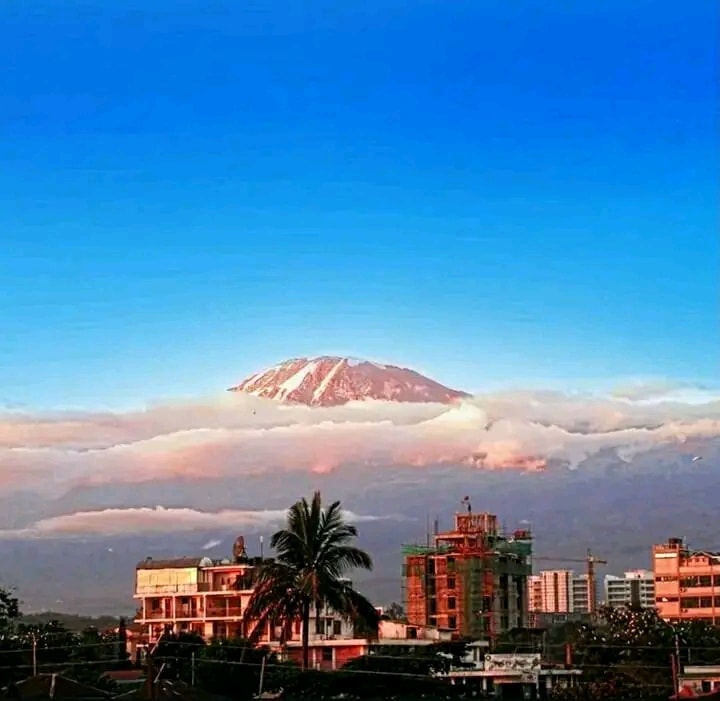
Mount Kilimanjaro emerging above the clouds, viewed from Moshi town with buildings and palm trees in the foreground during sunrise.
As the capital of Kilimanjaro region, Moshi city serves as the administrative and commercial heart of northern Tanzania.
This compact yet vibrant urban center plays a crucial role in governing one of the country’s most important tourism and agricultural regions.
Administrative Structure
Moshi city’s well-organized municipal framework comprises 21 distinct wards, further divided into 60 smaller hamlets.
This detailed administrative breakdown allows for efficient governance of Tanzania’s smallest municipality by area.
Despite covering just 59 square kilometers, the city’s structure supports its population of 221,733 residents through localized services and community representation.
The municipal government operates from the city center, coordinating regional development projects and maintaining infrastructure across all wards.
Urban Landscape
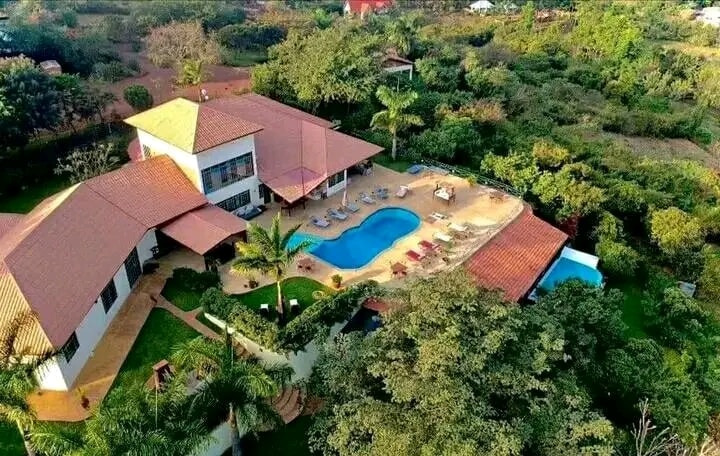
Aerial view of a luxury lodge with a swimming pool surrounded by lush greenery in Moshi, Northern Tanzania
The city center features a mix of colonial-era buildings and modern structures housing government offices, banks, and commercial establishments.
In the western part of Moshi, the urban landscape gradually gives way to residential neighborhoods and the foothills of Kilimanjaro.
Several bustling markets, including the main Mawenzi Market, offer everything from fresh produce to local crafts, serving as important social and economic hubs for residents.
Economic Hub
Moshi city stands out among other cities in Tanzania for its dual economic focus on government services and tourism support.
As the regional capital, it hosts numerous government offices handling Kilimanjaro region’s administrative affairs.
Simultaneously, the city serves as a financial center for northern Tanzania, with multiple banks and financial institutions supporting both local businesses and the tourism industry.
The modern cityscape of Moshi belies its long history, which stretches back to the pre-colonial era when the area was part of the Chagga kingdom.
Moshi Town Historical Evolution
Chagga Kingdom Era
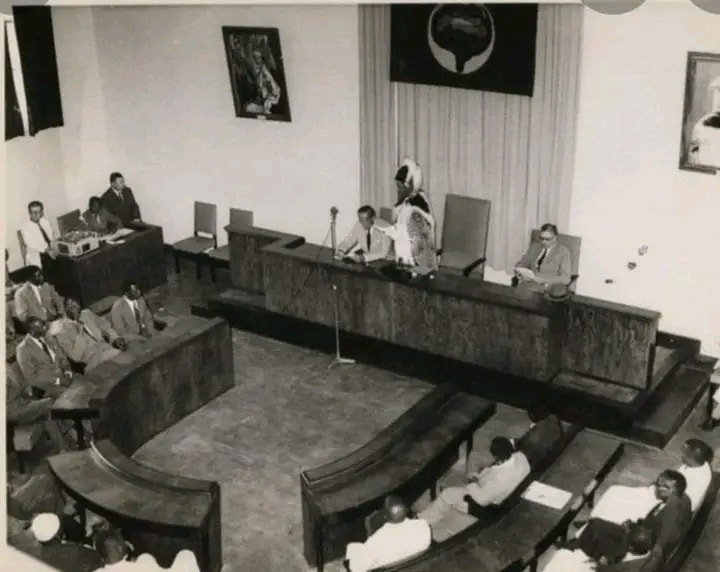
Historic photo of Chief Thomas Marealle addressing the Chagga Council in a formal assembly hall in Moshi, Northern Tanzania in 1952
Long before becoming a modern Tanzanian town, the Moshi area was part of the influential Chagga Kingdom.
The Chagga people established sophisticated agricultural communities on Kilimanjaro’s fertile slopes, developing irrigation systems and trade networks.
Their traditional governance system, centered around local chiefs, created a stable society that thrived through coffee cultivation and cattle keeping.
This pre-colonial heritage still influences Moshi’s cultural identity today.
Colonial Transformation
The arrival of German colonial authorities in the late 19th century dramatically changed Moshi.
After establishing a military camp following their 1892 victory in the Battle of Moshi, the Germans developed infrastructure including the crucial railway connection to Tanga.
Under Great Britain’s administration after World War I, Moshi became a center for opposition politics and the growing independence movement, while maintaining its importance as an agricultural hub.
Modern Development
Moshi officially gained town status in 1956, marking its transition from a colonial outpost to a proper urban center.
The town’s growth accelerated after Tanzania’s independence, leading to its designation as a municipality in 1988.
Today, Moshi preserves its historical legacy while serving as a modern gateway to Kilimanjaro, with colonial-era buildings standing alongside contemporary developments that support its tourism economy.
Geography & Climate
Mountain Proximity Effectsand
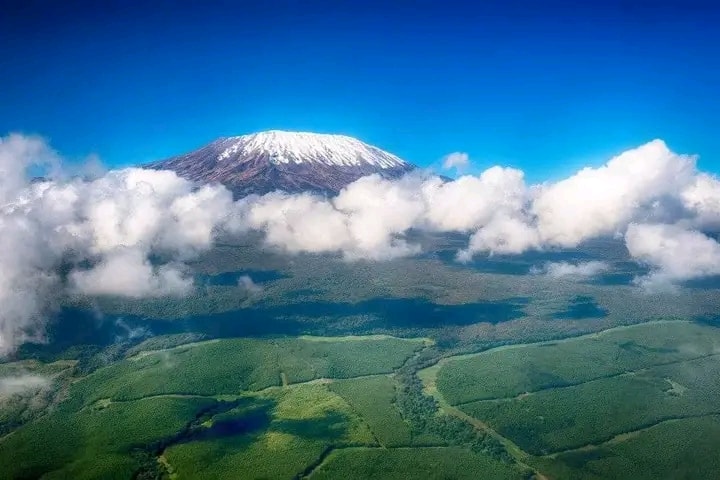
Mount Kilimanjaro with its snow-capped peak rising above the clouds and lush green forest below.
Situated at approximately 890 meters above sea level on Kilimanjaro’s lower slopes, Moshi enjoys a cooler climate than surrounding lowlands.
The mountain’s massive presence creates unique microclimates, with altitude cooling tempering the tropical heat.
Monsoon patterns bring distinct seasonal variations – the northeast monsoon from December to March carries warm, dry air, while the southeast monsoon (April–November) delivers moisture from the Indian Ocean.
These air currents interact with Kilimanjaro’s elevation to create the area’s characteristic weather patterns.
Seasonal Guide
The best time to visit Moshi is during the drier months from June to October and January to February, when clear skies offer spectacular mountain views.
The long rainy season (March–May) transforms the landscape lush green but makes outdoor activities challenging.
A short rainy period occurs in November–December, with brief afternoon showers.
Year-round, temperatures remain comfortable, averaging 25°C (77°F) during the day and cooling to 15°C (59°F) at night, making Moshi an agreeable destination in any season.
Mount Kilimanjaro: Africa’s Crown Jewel

A snow-capped Mount Kilimanjaro towering above the plains
Geological Profile
Dominating the landscape north of Moshi, Mount Kilimanjaro stands as Africa’s highest mountain at 5,895 meters (19,341 feet).
This massive dormant volcano consists of three distinct volcanic cones – Kibo, Mawenzi, and Shira.
The mountain’s slopes transition through five dramatic ecological zones: cultivated foothills, lush rainforest, heath and moorland, alpine desert, and finally the arctic summit zone with its famous glaciers and snowfields.
These diverse environments make Kilimanjaro one of the world’s most remarkable natural wonders.
Kilimanjaro National Park
The mountain is protected within Kilimanjaro National Park, a UNESCO World Heritage Site.
The park’s lower rainforest zone shelters diverse wildlife including blue monkeys, bushbabies, and over 150 bird species.
The Sanya plains at the mountain’s base provide critical grazing land for elephants and buffalo that migrate between the park and surrounding ecosystems.
Park regulations help preserve Kilimanjaro’s fragile environments while allowing sustainable tourism.
Climb Kilimanjaro
For adventurous visitors, climbing Kilimanjaro offers a life-changing experience.
Seven main routes – including popular options like Marangu, Machame, and Lemosho – provide varying difficulty levels and scenery.
Preparation should include physical training, proper gear, and altitude acclimatization. Most climbs take 5–9 days, with success rates significantly higher on longer itineraries.
Moshi serves as the primary base for organizing climbs, with numerous licensed operators offering guided expeditions.
The climb requires no technical skills but demands endurance to reach Uhuru Peak, where breathtaking sunrise views reward determined hikers.
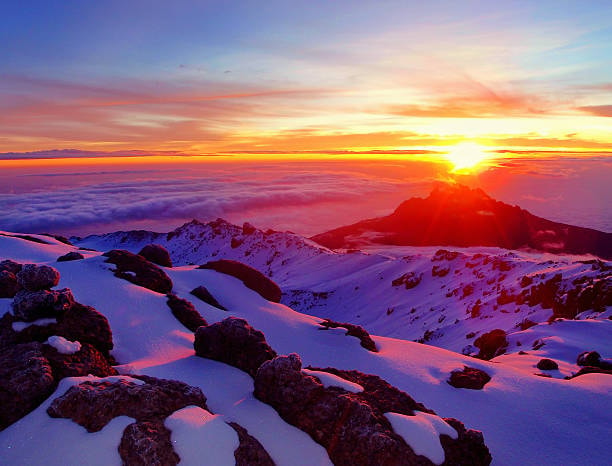
Sunrise at summit of Kilimanjaro
Tourism Circuit & Attractions
Northern Safari Circuit
Moshi serves as an ideal base for exploring Tanzania’s famous northern safari circuit.
Arusha National Park, just an hour’s drive away, offers stunning views of Mount Meru and the chance to see giraffes, zebras, and flamingos at the Momela Lakes.
The circuit extends to other national parks including Tarangire, known for its elephant herds; Lake Manyara, with its tree-climbing lions; and the world-famous Serengeti and Ngorongoro Crater.
These parks showcase East Africa’s incredible biodiversity and can be visited on multi-day safaris or as day trips from Moshi.
Lake Chala
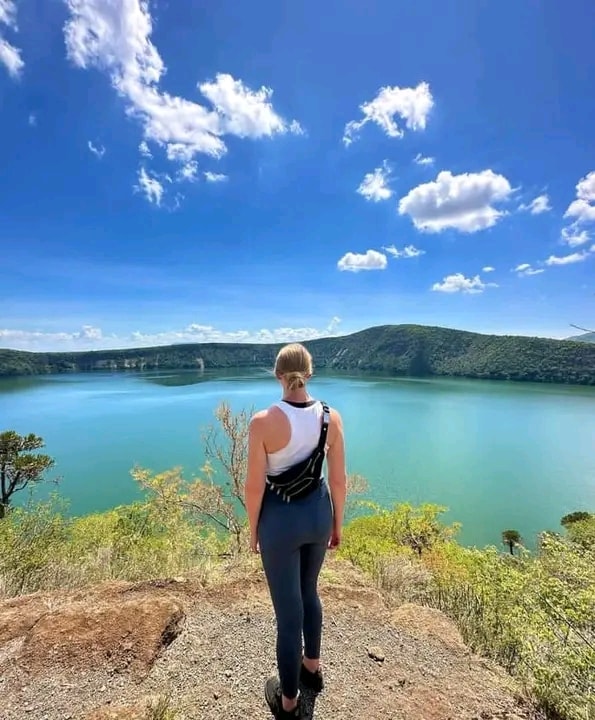
Woman overlooking Lake Chala near Moshi
This stunning crater lake straddles the Tanzania–Kenya border about 35 km from Moshi.
Formed in a volcanic caldera, Lake Chala’s deep blue waters change color throughout the day.
Visitors can hike around the rim for breathtaking views or descend to the shore for swimming and picnics.
The lake’s unique ecosystem supports diverse birdlife and is surrounded by lush vegetation.
Materuni Waterfalls
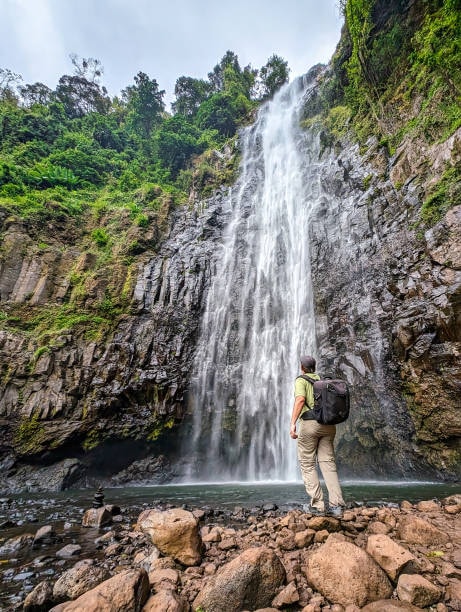
Man standing in front of Materuni Waterfalls near Moshi, surrounded by lush greenery and rocky cliffs
The picturesque Materuni Waterfalls cascade 80 meters down moss-covered rocks in a lush valley.
The hike to the falls passes through coffee plantations and offers opportunities to see several waterfalls along the route.
At the main falls, visitors can swim in the cool pool below.
The area is also known for its coffee culture, with many tours combining waterfall visits with traditional coffee-making demonstrations.
Hot Springs & More
The Chemka (Kikuletwa) Hot Springs feature crystal-clear warm waters surrounded by palm trees and fig roots, creating a perfect oasis for swimming.
Ngurdoto Crater, often called “Little Ngorongoro,” offers excellent hiking and wildlife viewing in a compact volcanic caldera.
Other nearby attractions include Marangu’s Chagga caves and the vibrant Moshi markets showcasing local crafts and produce.
Coffee Culture & Tours
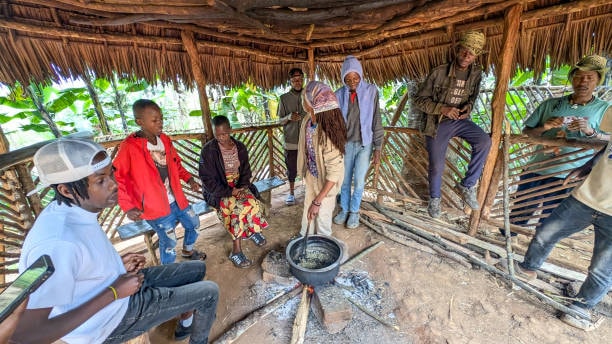
Group of coffee farmers roasting coffee beans using traditional method
Historical Roots
The coffee culture in Moshi traces back to 1893 when Roman Catholic missionaries first introduced Arabica coffee plants to the region.
The Chagga people quickly adopted coffee cultivation, recognizing its potential in the fertile volcanic soils of Kilimanjaro’s slopes.
This agricultural tradition has been passed down through generations, with small family-owned coffee plantations becoming the backbone of Moshi’s economy.
Today, the region produces some of Tanzania’s finest specialty coffees, maintaining century-old farming techniques alongside modern production methods.
Coffee Making Process
Visitors can witness the complete journey from bean to cup during coffee tours.
The process begins with hand-picking ripe red cherries between June and December.
Workers then pulp the cherries to remove the outer skin, ferment the beans for 24–36 hours, and sun-dry them on raised beds.
After drying, the parchment is removed by hulling, revealing the green coffee beans ready for roasting.
Many plantations still use traditional wood-fired roasters, where masters judge readiness by color and aroma.
The final product showcases the distinct flavor profiles influenced by Kilimanjaro’s unique terroir.
Coffee Tour Experience
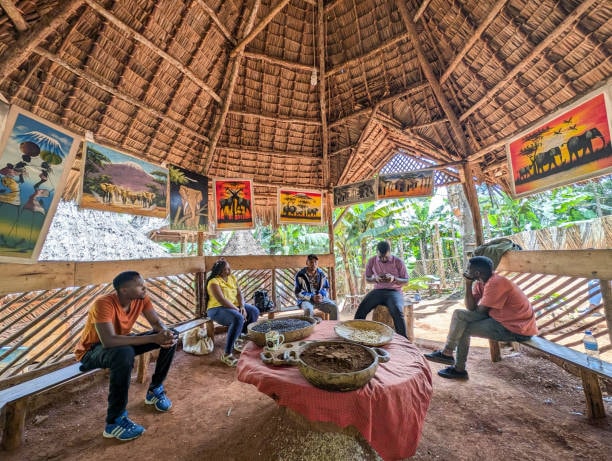
Group of tourists listening to a guide expalining the coffee production process
A typical coffee tour through local coffee plantations allows visitors to participate in harvesting and processing while learning to distinguish different tastes from various elevations.
Tours often conclude with cupping sessions where guests sample light, medium, and dark roasts, appreciating notes ranging from citrusy brightness to chocolatey depth.
Many plantations combine coffee experiences with cultural activities, offering a comprehensive taste of Chagga traditions.
Cultural Tapestry
Indigenous Heritage
The Chagga people have shaped Moshi’s cultural identity through their ingenious terraced farming techniques, developed over centuries on Kilimanjaro’s slopes.
Their traditional round huts with conical thatched roofs still dot the countryside, though most families now live in modern homes.
Tribal traditions remain vibrant through storytelling, ceremonial dances honoring the mountain, and the enduring clan system.
Visitors can experience authentic Chagga culture at living museums, where elders demonstrate traditional crafts, brewing techniques for banana beer, and the famous underground defense tunnels used during tribal conflicts.
Culinary Journey
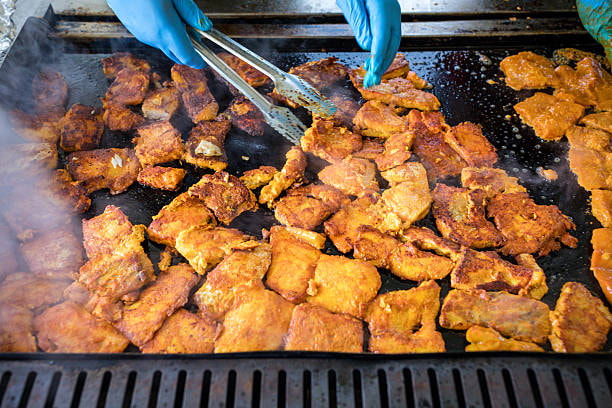
Traditional Chagga barbecue setup under a thatched hut in Moshi
Moshi’s food markets burst with flavors reflecting Tanzania’s culinary diversity. The main language spoken in these bustling hubs is Swahili, though you’ll hear Chagga dialects and international tongues too.
Tanzanian cuisine here blends local staples like ugali (maize porridge) with coastal Swahili spices and Indian influences from colonial times.
Must-try dishes include:
| Dish | Description |
|---|---|
| Mchuzi wa Ndizi | (plantain stew with coconut milk) |
| Nyama Choma | (grilled meat, often goat or beef) |
| Mandazi | (sweet fried dough) with locally grown coffee |
The fusion continues in modern restaurants where chefs creatively combine these traditions with global techniques, making Moshi an unexpected foodie destination.
Practical Travel Guide
Getting There
Most international visitors arrive via Kilimanjaro International Airport (JRO), located about 40 km west of Moshi.
Regular shuttle services and taxis connect the airport to town in under an hour.
For travelers coming from Dar es Salaam, direct flights operate daily, while comfortable buses make the 8-hour journey by road.
Within Moshi, boda bodas (motorcycle taxis) provide affordable local transport, though negotiate fares beforehand.
The town’s compact size makes many attractions walkable, while organized tours handle transportation to more distant sites like national parks.
Accommodation

Poolside relaxation with cocktails in Moshi
Moshi offers diverse hotels catering to all budgets and preferences.
Budget travelers find clean hostels from $30/night, while mid-range hotels ($80–120) typically feature swimming pools and restaurant services.
Luxury options include boutique lodges with Kilimanjaro views and premium amenities.
Many hotels specialize in serving climbers, offering gear storage, packed lunches, and pre-climb briefings.
For authentic local experiences, consider staying at a coffee plantation guesthouse in the surrounding villages.
Events & Timing
Plan visits around Moshi’s signature event – the Kilimanjaro Marathon held annually in early March, attracting runners worldwide.
The dry seasons (June–October and January–February) offer optimal conditions for climbing and safaris.
Avoid heavy rains in April–May when some trails become impassable.
Major cultural festivals like Nane Nane (August) showcase Chagga traditions, while weekly markets provide year-round opportunities to engage with local artisans and farmers.
Conclusion
Moshi embodies the spirit of East Africa, blending breathtaking landscapes with rich cultural heritage.
As the gateway to Kilimanjaro Moshi, this vibrant town invites travelers to experience Tanzania beyond the safari circuit.
Whether summiting Africa’s highest peak, exploring coffee plantations, or immersing in Chagga traditions, visitors discover Moshi’s authentic charm.
The town’s perfect balance of adventure infrastructure and local character makes it an ideal base for exploring northern Tanzania’s wonders.
More than just a stopover, Moshi offers a profound connection to East Africa’s natural beauty and living traditions that continues to call travelers back.
Frequently Asked Questions
What is Moshi known for?
Moshi is best known as the gateway to Mount Kilimanjaro, the highest peak in Africa. It’s also famous for its lush coffee plantations on the mountain slopes and the vibrant Swahili-Chagga culture, which includes traditional dance, cuisine, and festivals.
When is the best time to visit Moshi?
The ideal time is during the dry seasons: June through October and January through February. During these months you can enjoy clear mountain views and comfortable weather. The rainy seasons (March–May and November–December) bring lush green scenery but can make hiking and outdoor tours more challenging.
What are the must-see attractions around Moshi?
Besides climbing Kilimanjaro, visitors often explore nearby highlights like Arusha National Park (for wildlife and Mt. Meru views), Lake Chala (a beautiful crater lake), Materuni Waterfalls (an 80m cascade), and the Chemka Hot Springs oasis. On safari circuit day-trips, Moshi is a good base for Tarangire, Lake Manyara, Serengeti and Ngorongoro Crater.
Is Moshi safe for tourists?
Generally, Moshi is considered safe for travelers. It is a friendly town accustomed to visitors. Normal precautions apply – keep an eye on belongings and follow local advice. Most tourists find the area welcoming and enjoy relaxed days and evenings in the town.
What languages are spoken in Moshi?
The main language is Swahili, which is used in markets and daily life. English is widely spoken in tourist areas, hotels and by guides. You’ll also hear Chagga dialects and other Tanzanian languages, reflecting the town’s local heritage and diverse visitors.
